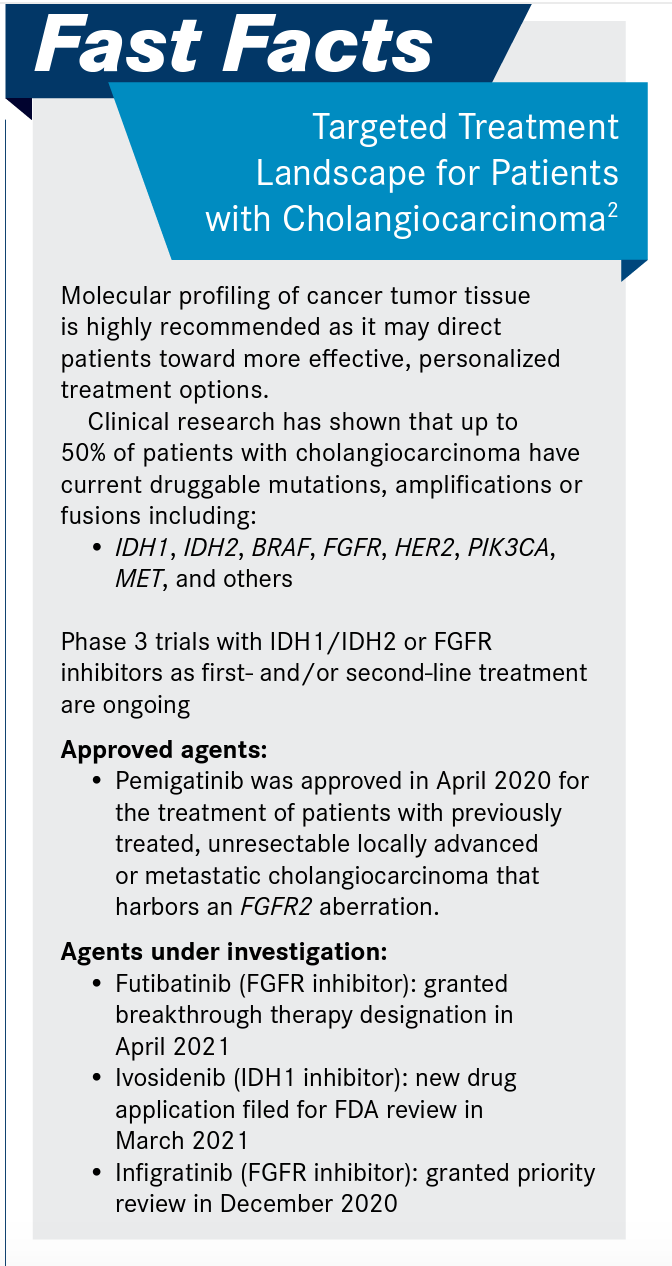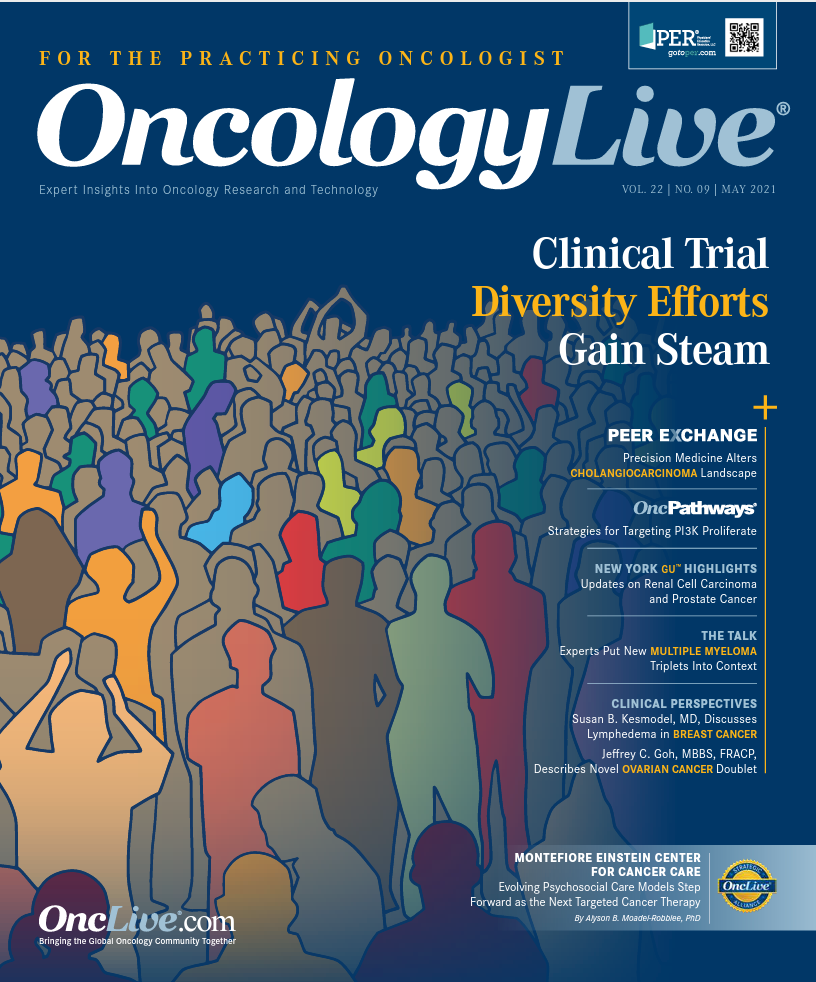Publication
Article
Oncology Live®
Finding the Golden Ticket in Cholangiocarcinoma: Entering the Era of Precision Medicine
Author(s):
The highly heterogeneous nature of cholangiocarcinoma at the genomic, epigenetic, and molecular levels has led to the development of effective new treatments for patients with these rare malignant tumors.
Robin Kate Kelley, MD

The highly heterogeneous nature of cholangiocarcinoma at the genomic, epigenetic, and molecular levels has led to the development of effective new treatments for patients with these rare malignant tumors. Cholangiocarcinoma, the second most common primary hepatic malignancy, often presents in advanced stages with reported 5-year survival outcomes of less than 10%.1,2
For the past decade, investigators have leaned on targeted therapeutic approaches to better understand these tumors and have finally opened the door to a plethora of new agents, some of which are already helping to improve outcomes for certain patient subsets.2
During a recent OncLive Peer Exchange®, a panel of gastrointestinal oncology experts discussed a variety of targetable genetic aberrations that have been observed in patients with cholangiocarcinoma. They also discussed several targeted treatments that are showing promise in patients with tumors that harbor such aberrations. These agents include FGFR inhibitors, the first of which was recently approved, and IDH inhibitors, with many others under active clinical investigation and expected to move into clinical practice in the coming years.
Identifying Targetable Genetic Aberrations
An increasing number of targets are being identified in cholangiocarcinoma. “I would say maybe up to 50% of [patients with] cholangiocarcinoma, particularly intrahepatic, may have an actionable or targetable therapy option,” R. Kate Kelley, MD, said. In patients with intrahepatic cholangiocarcinoma, IDH1 mutations and FGFR2 gene fusions have been the most frequent alterations identified. Less common targets include BRAF mutations, NTRK fusions, ROS1 fusions, and microsatellite instability- high (MSI-H) status, which Kelley said may also be observed in some patients with extrahepatic disease. Additionally, HER2 amplification or overexpression may also be present in some cases of extrahepatic disease.
“Those are the golden tickets we don’t want to miss,” she said.
Since targetable genetic aberrations are rare, some providers may experience “precision medicine frustration and fatigue” when testing for them, moderator John L. Marshall, MD, said. “A [small] return rate on a disease that you might only see 5 or 6 times a year may not feel worth it, but I think part of what we want to emphasize is the importance of doing this correctly using today’s standards, so if that golden ticket is actually sitting across from you in the exam room, you don’t miss it,” he explained.
John L. Marshall, MD

The panelists proceeded to discuss which methods they use to assess for actionable targets. “We’ve evolved to using next-generation sequencing [NGS], but not all next-generation sequencing is the same,” panelist Sameek Roychowdhury, MD, PhD, said. He explained that the NGS test used should include RNA sequencing. “RNA testing is particularly valuable for fusions. As long as you’re doing DNA and RNA testing, you’re likely to capture all these genes, mutations, amplifications, and gene fusions or rearrangements,” he said. If tissue-based NGS is not safe, feasible, or possible because of time constraints, Roychowdhury said liquid biopsy can be considered but noted that this modality is likely to miss 10% to 40% of gene fusions. “If it’s positive, it’s positive, and if it’s negative, I wouldn’t discount another gene being present.”
Because cholangiocarcinoma is such a heterogeneous cancer and targets are rapidly changing as the disease is becoming better understood, the panelists emphasized the importance of working with industry partners who have the most up-to-date platforms vs trying to handle testing internally. Speaking from experience, Milind Javle, MD, said, “We had our own fantastic [internal assay] panel, but [we struggled to explain to] people that we were not going to send tissue there because it doesn’t check FGFR fusions. At this point, there are 150 fusions. The current platform that we have does detect fusions, but I think there’s variability…there should be some uniformity and certain standards, which I don’t believe there are at this point,” she said.
If feasible, it is important that molecular testing be conducted as early as possible. “I recommend earlier testing, especially for advanced or metastatic cholangiocarcinoma,” Roychowdhury said. “[When a diagnosis is f irst made], you could get a good tissue specimen and start gemcitabine/cisplatin, maybe [consider] a clinical trial, and do early testing so that you can start thinking about and have time to get those results.” He noted that this strategy helps give providers more breathing room to find solutions for addressing any targetable genetic findings, especially those that may not be standard of care yet. “Maybe you need to find that patient a clinical trial, or maybe you’re going to have to do some complicated paperwork to figure out how to get them an ERBB2 inhibitor, because [the agent] is not yet approved for that indication,” he explained.
FGFR Inhibitors
The body of data on FGFR inhibitors is rapidly growing, Kelley said. She noted that the most data are currently available for activating FGFR2 fusions or rearrangements, which is the target of pemigatinib (Pemazyre), the first FDA-approved FGFR inhibitor for cholangiocarcinoma, and infigratinib, which was granted priority review by the FDA in December 2020.3,4 Both of these agents are ATP-competitive inhibitors. There has also been promising data around futibatinib, which is a non-ATP competitive covalent inhibitor that targets kinase in a different location and has shown activity in resistance, she said. Based on such findings, specifically the phase 2 FOENIXCCA2 trial (NCT02052778), the FDA granted futibatinib breakthrough therapy designation on April 1, 2021, for patients with previously treated, locally advanced, or metastatic cholangiocarcinoma harboring FGFR2 gene rearrangements, including fusions.5
Sameek Roychowdhury, MD, PhD

Pemigatinib
Pemigatinib was granted accelerated approval on April 17, 2020, along with the FoundationOne CDX as a companion diagnostic for patient selection.3 Approval was based on data from FIGHT-202 (NCT02924376), a multicenter, open-label, single-arm trial that included 107 patients with locally advanced unresectable or metastatic cholangiocarcinoma that progressed after at least 1 prior therapy and had an FGFR2 gene fusion or rearrangement.
“[Data from] FIGHT-202 showed durable and pretty deep responses, with the waterfall plot showing a pretty substantial regression in almost all patients. With this drug, the uniformity of the regressions and the durability led to an accelerated FDA approval, even in the absence of a randomized trial,” Kelley said.
After a median follow-up of 17.8 months, the overall response rate (ORR) was 36%, which included 3 complete responses (CRs) and 35 partial responses (PRs).3,6 The median duration of response (DOR) was 9.1 months with responses lasting at least 6 months in 24 of the 38 (63%) responders and at least 12 months in 7 (18%) responders. The most common adverse effect (AE) across grades was hyperphosphatemia (60%). In February 2021, the label for pemigatinib was updated to include a warning and a recommended dosage of 9 mg orally once daily for 14 consecutive days followed by 7 days off therapy, in 21-day cycles for patients with severe hepatic impairment, defined as total bilirubin greater than 3 × upper limit of normal with any aspartate aminotransferase.6,7
Pemigatinib is currently being studied in FIGHT-302 (NCT03656536), a phase 3 trial comparing pemigatinib with gemcitabine plus cisplatin in treatment-naïve patients with advanced cholangiocarcinoma harboring FGFR2 rearrangements.8 The study plans to enroll more than 400 patients globally and is currently recruiting patients.
Infigratinib
Infigratinib has shown comparable results to pemigatinib, Kelley said. Like pemigatinib, it was studied in a single-arm, phase 2 study (NCT02150967).9 The study included 108 patients with FGFR2 gene fusions or rearrangements, 54% of who had received at least 2 prior treatments. After a median follow-up of 10.6 months, the ORR was 23.1% and included 1 CR and 24 PRs. The median DOR was 5 months (range, 0.9-19.1). Among the responders, 32% had a DOR lasting at least 6 months. The median progression-free survival (PFS) was 7.3 months (95% CI, 5.6-7.6). In a subset analysis, the ORR for those receiving infigratinib in the secondline setting was 34%. For those receiving it in the third and later lines the ORR was 13.8%.
The AE profile of infigratinib was comparable to that of pemigatinib. The most common treatment-emergent AEs included hyperphosphatemia (76.9%); eye disorders, excluding central serous retinopathy (CSR) and retinal pigment epithelial detachment (RPED; 67.6%); stomatitis (54.6%); and fatigue (39.8%). CSR/RPED was observed in 16.7% of patients, including 1 who experienced an AE that was grade 3. Other common grade 3/4 AEs included stomatitis (14.8%), hyponatremia (13.0%), and hypophosphatemia (13.0%), all of which were grade 3 except 1 case of hypophosphatemia.
Milind Javle, MD

Although infigratinib and pemigatinib are both ATP-competitive inhibitors, Javle noted some differences between them. “Infigratinib is an ATP-competitive inhibitor very specific for FGFR1, FGFR2, and FGFR3. It has much less FGFR4 activity compared with some of the other agents, such as pemigatinib and futibatinib, and it’s very potent for FGFR2,” he said.
Investigators are evaluating infigratinib in the phase 3 PROOF 301 trial (NCT03773302), which is comparing the agent with gemcitabine plus cisplatin in treatment-naïve patients with advanced cholangiocarcinoma harboring FGFR2 gene fusions or translocations.10 Whereas the FIGHT-302 trial uses 1:1 randomization to pemigatinib or gemcitabine plus placebo, the PROOF 301 trial will have 2:1 randomization to infigratinib or gemcitabine plus placebo.8,10
Futibatinib
At the time of the Peer Exchange, data for futibatinib were not reported and the panelists were very hopeful about the drug’s prospects. Whereas the ultimate hope with pemigatinib and infigratinib is that they will enable a chemotherapy-free, targeted therapy option in the front line, along with any subsequent-line indications, another hope is that futibatinib will provide a powerful second- and subsequent-line option for patients, including those previously treated with pemigatinib or infigratinib who may have acquired a resistance mutation, Kelley said. “The wave of the future may be nuancing this pathway and learning how to inhibit it sequentially like we have in EGFR-mutated lung cancer or ALK-fusion lung cancer. FGRF is a huge space,” she said.
Recently, Taiho Oncology, the manufacturer of futibatinib, presented the safety and efficacy results from the phase 2, single-arm FOENIX-CCA2 trial, which evaluated futibatinib in 103 patients with intrahepatic cholangiocarcinoma harboring FGFR2 gene rearrangements, including gene fusions, who progressed after at least 1 line of therapy.11 The ORR was 41.7% (95% CI, 32.1%-51.9%) and responses were durable, with a median DOR of 9.7 months (95% CI, 7.6-17.0). Among responders, 72% maintained their responses at least 6 months and 14% maintained a response of at least 12 months. The median PFS was 9.0 months (95% CI, 6.9-13.1). The overall survival data (OS) at the time of presentation was immature and ongoing with investigators reporting median OS of 21.7 months (95% CI, 14.5-not reached), with 72% of patients alive at 12 months.
Treatment-related AEs were similar to those observed with pemigatinib and infigratinib, with hyperphosphatemia (85%), alopecia (33%), and dry mouth (30%) being most common.11 The most frequent grade 3 AE was hyperphosphatemia (30%), which resolved with adequate management. One case of grade 4 increase in serum alanine aminotransferase was observed, but there were no treatment-related deaths.
Fast facts: Targeted Treatment Landscape for Patients with Cholangiocarcinoma2

Dealing With FGFR Inhibitor-Related AEs
With one FGFR inhibitor already FDA-approved and other approvals anticipated, Javle noted that while these agents have general systemic AEs, such as alopecia, nail changes, mucositis, and arthralgia. Other AEs may require special consideration before use. These include mechanism- related AEs, particularly hyperphosphatemia, and bodily changes, such as the ocular AEs, which he said are the most important to watch out for. “[Ocular monitoring] is not usually in the armamentarium of investigations, such as ophthalmological examination every 2 or 3 months, along with OCT [optical coherence tomography]. We have learned to do that,” he said.
As for hypophosphatemia, which occurs less commonly than hyperphosphatemia, Javle said a patient’s serum phosphorous levels should be periodically measured and the condition can usually be managed with “dietary restriction of phosphates as a first step, [adding] a chelating agent as a second step, and then dose reduction as a third step.” He noted that although none has been observed, an important question is whether this AE has any clinical consequences.
Kelley said hyperphosphatemia is more concerning as it is associated with a risk of ectopic calcification and affects approximately 70% of patients. “Most patients on these drugs end up taking a binder such as sevelamer [Renvela, Renagel] which we would use [for] a patient with chronic kidney disease,” she said, noting these agents are not given as prophylaxis but when serum phosphorous levels are found to be elevated.
IDH1 Inhibition
IDH1 inhibitors are not fundamentally cytotoxic and work through a completely different mechanism from most cancer treatments, Kelley said. She explained that the IDH gene, particularly IDH1, causes the oncometabolite 2-hydroxyglutarate to accumulate downstream in the cell microenvironment, causing a differentiation block that leads to a proliferation of immature cells and subsequent oncogenesis. IDH1 inhibitors attempt to reestablish normal differentiation. “Approximately 15% of [patients with] intrahepatic cholangiocarcinomas have an IDH1 mutation. We think this is also a distinct clinical phenotype, just like FGFR,” Kelley said.
An IDH1 inhibitor showing promise in cholangiocarcinoma is ivosidenib (Tibsovo), an agent approved for patients with acute myeloid leukemia (AML).12 While this agent has not shown dramatic response rates, it has been associated with improved PFS in data from the phase 3 ClarIDHy trial (NCT02989857). The median PFS for patients treated with ivosidenib (n = 124) was 2.7 months (95% CI, 1.6-4.2) vs 1.4 months (95% CI, 1.4-1.6) for those who received placebo (n = 61; HR, 0.37; 95% CI, 0.25-0.54; one-sided P = .0001).13
Although these numbers appear low, Kelley explained that there are some challenges with interpreting the data, such as the heterogeneity of the second- and third-line patients included. Nevertheless, the hazard ratio was significant. “There’s a distinct tail of the curve. We think this is a statistically positive trial, and although the absolute numbers are low, there’s a subset of patients who seem to be deriving a benefit,” she said.
Overall, ivosidenib was well tolerated, with ascites being the most common grade 3 or worse AE, affecting 7% of patients in the placebo and ivosidenib cohorts. Based on the safety and efficacy findings, on March 1, 2021, the drug’s manufacturer, Agios Pharmaceuticals, submitted a new drug application to the FDA requesting priority review of ivosidenib as a potential treatment for patients with previously treated IDH1-mutated cholangiocarcinoma.14
A Reason for Hope
The panelists said they were hopeful about the evolving treatment landscape for advanced cholangiocarcinoma. “I see futures in so many of these heterogeneous subsets; they will start classifying and nuancing themselves, whether it’s FGFR2, IDH1, or MSI-high, and as we go, we’ll discover more,” Kelley said, noting that these distinctions will enable providers to “finesse and tailor treatments to the individual patient’s tumor.”
Roychowdhury explained that while cholangiocarcinoma can lead to thoughts of poor survival and feelings of pessimism, the opportunities to improve care and outcomes are growing. “There is hope, and there are good therapies. Whether it’s standard therapies or clinical trials, we’ve got great options for these patients. Don’t be afraid of this disease. Don’t give up,” he said.
References
- Survival rates for bile duct cancer. American Cancer Society. Updated January 27, 2021. Accessed April 20, 2021. https://bit.ly/3dpungc
- Banales JM, Marin JJG, Lamarca A, et al. Cholangiocarcinoma 2020: the next horizon in mechanisms and management. Nat Rev Gastroenterol Hepatol. 2020;17(9):557-588. doi:10.1038/s41575-020-0310-z
- FDA grants accelerated approval to pemigatinib for cholan-giocarcinoma with an FGFR2 rearrangement or fusion. FDA. Updated April 20, 2020. Accessed April 20, 2021. https://bit.ly/3ecIZyE
- BridgeBio Pharma and affiliate QED Therapeutics announce FDA acceptance of new drug application for infigratinib for the treatment of cholangiocarcinoma. News release. Bridge-Bio Pharma. December 1, 2020. Accessed April 20, 2021. https://bit.ly/36sxwZe
- FDA grants breakthrough therapy designation for Taiho Oncology’s futibatinib for treatment of advanced cholangio-carcinoma. News release. Taiho Oncology, Inc. April 1, 2021. Accessed April 20, 2021. https://prn.to/3udl7RV
- Abou-Alfa GK, Sahai V, Hollebecque A, et al. Pemigatinib for previously treated, locally advanced or metastatic cholangiocarcinoma: a multicentre, open-label, phase 2 study. Lancet Oncol. 2020;21(5):671-684. doi:10.1016/S1470-2045(20)30109-1
- Pemazyre. Prescribing information. Incyte Corporation; 2021. Accessed April 20, 2021. https://www.accessdata.fda.gov/drugsatfda_docs/label/2021/213736s001lbl.pdf
- Bekaii-Saab TS, Valle JW, Van Cutsem E, et al. FIGHT-302: first-line pemigatinib vs gemcitabine plus cisplatin for advanced cholangiocarcinoma with FGFR2 rearrangements. Future Oncol. 2020;16(30):2385-2399. doi:10.2217/fon-2020-0429
- Javle MM, Roychowdhury S, Kelley RK, et al. Final results from a phase II study of infigratinib (BGJ398), an FGFR-selective tyrosine kinase inhibitor, in patients with previously treated advanced cholangiocarcinoma harboring an FGFR2 gene fusion or rearrangement. J Clin Oncol. 2021;39(suppl 3): 265. doi:10.1200/JCO.2021.39.3_suppl.265
- Phase 3 study of BGJ398 (oral infigratinib) in first line chol-angiocarcinoma with FGFR2 gene fusions/translocations. Updated January 27, 2021. Accessed April 20, 2021. https://clinicaltrials.gov/ct2/show/NCT03773302
- Goyal L, Meric-Bernstam F, Hollebecque A, et al. Primary results of phase 2 FOENIX-CCA2: The irreversible FGFR1-4 inhibitor futibatinib in intrahepatic cholangiocarcinoma (iCCA) with FGFR2 fusions/rearrangements. Presented at: American Association for Cancer Research 2021 Annual Meeting. April 10-15, 2021; virtual. Abstract CT010. https://www.abstract-sonline.com/pp8/#!/9325/presentation/5141
- Tibsovo. Prescribing information. Agios Pharmaceuticals Inc; 2019. Accessed April 20, 2021. https://www.accessdata.fda.gov/drugsatfda_docs/label/2019/211192s001lbl.pdf
- Abou-Alfa GK, Macarulla T, Javle MM, et al. Ivosidenib in IDH1-mutant, chemotherapy-refractory cholangiocarcinoma (ClarIDHy): a multicentre, randomised, double-blind, place-bo-controlled, phase 3 study. Lancet Oncol. 2020;21(6):796-807. doi:10.1016/S1470-2045(20)30157-1
- Agios submits supplemental new drug application to FDA for TIBSOVO (ivosidenib tablets) for patients with previously treat-ed IDH1-mutant cholangiocarcinoma. News release. March 1, 2021. Accessed April 20, 2021. http://bit.ly/301kg9R
























%20(2)%201-Recovered-Recovered-Recovered-Recovered-Recovered-Recovered-Recovered-Recovered-Recovered-Recovered-Recovered-Recovered-Recovered-Recovered-Recovered-Recovered-Recovered.jpg?fit=crop&auto=format)
%20(2)%201-Recovered-Recovered-Recovered-Recovered-Recovered-Recovered-Recovered-Recovered-Recovered-Recovered-Recovered-Recovered-Recovered-Recovered-Recovered-Recovered-Recovered.jpg?fit=crop&auto=format)
